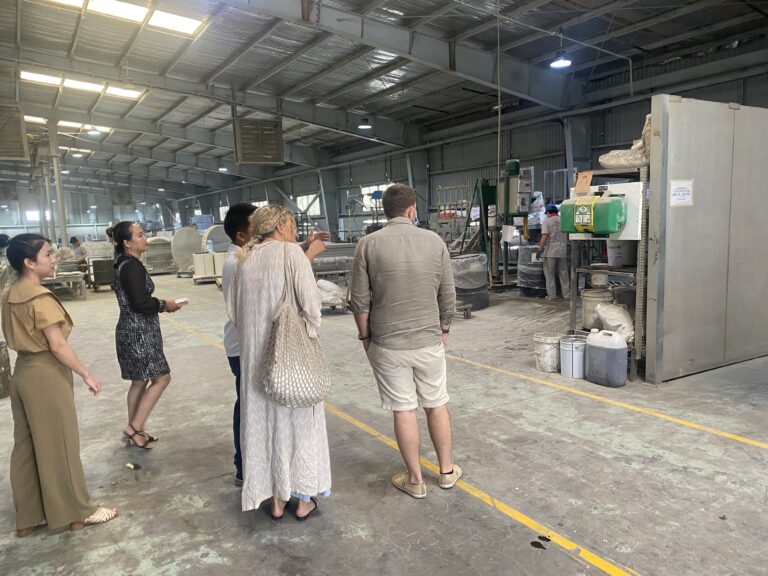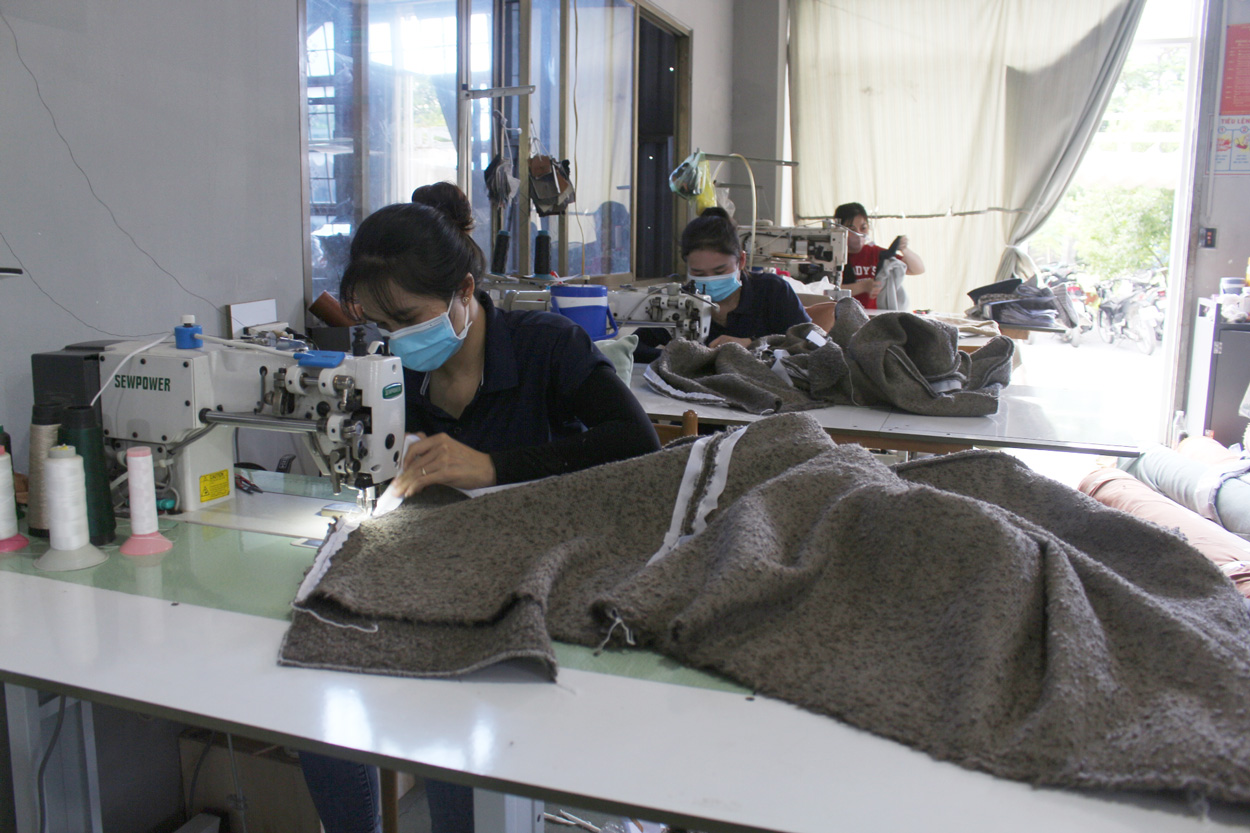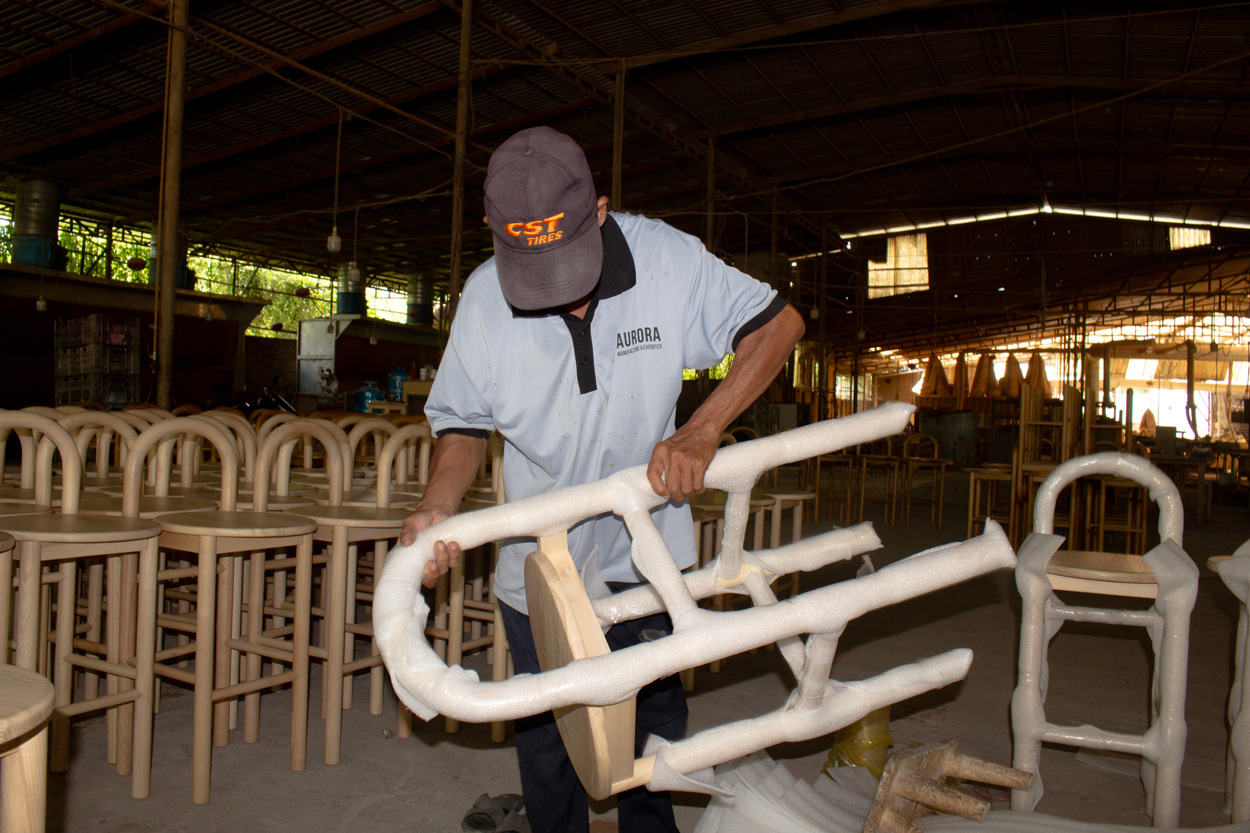Standard B2B Furniture Supplier Checklist
A furniture supplier checklist is truly a “power tool” that helps businesses confidently partner with a factory without worrying about hidden risks. In this guide, Aurora Craft will share how to build a practical, easy-to-use supplier checklist that any company can apply right away — so you can “filter” for qualified partners from day one. Let’s dive in!
Why should you have a furniture supplier checklist?
To avoid poor-quality products, unexpected delays, or unnecessary hidden costs, every business should prepare a clear furniture supplier checklist before signing any contract.
Think of this furniture supplier checklist as a smart filter — helping your team verify the real capacity, workflow, and credibility of any furniture manufacturer. With a clear list in hand, both sides can stay proactive during negotiations and have full visibility throughout production.

A solid furniture supplier checklist usually covers the following key points:
Before signing a contract:
- Supplier qualification guide
- Factory audit furniture
- Social compliance audit
- Furniture sourcing due diligence
During the contract stage:
- MOQ negotiation furniture
- Sample approval process
- Quality inspection furniture
- Third-party QC furniture
- Lead-time verification
These criteria ensure you receive exactly what you ordered — in the right quality, quantity, and timeline. More importantly, they help build a transparent, sustainable partnership with your furniture supplier.
Aurora Craft invites you to explore each essential checklist item in detail below — so your next sourcing decision is clear, confident, and worry-free.
>>> Read more: Asia Furniture Show 2026: A Golden Opportunity for Global Businesses.
Top 4 Checks in Your Furniture Supplier Checklist Before Signing a Contract
By setting up these 4 must-have checks before signing any deal, your business can see clearly if a furniture supplier is truly the right partner to trust and invest in.
Check Supplier Qualifications
Checking supplier qualifications is all about verifying whether a supplier truly meets the minimum standards required to join your supply chain. This is the first and one of the most critical steps — helping your business make sure you’re partnering with a capable, reliable factory from day one.
A thorough supplier qualification check typically includes:
Step 1: Define your evaluation criteria — for example: management system, technical capacity, factory scale, financial stability, and legal documents.
Step 2: Prepare and send out a detailed pre-qualification questionnaire for the supplier to complete honestly.
Step 3: Collect supporting files and proof — including copies of legal certificates, audit reports, factory images, production line photos, and workforce capacity.
Step 4: Conduct an on-site or virtual visit — send your representative to the factory or arrange an online meeting to verify information face-to-face.
Step 5: Categorize and make your final decision — record results clearly: if the supplier qualifies, add them to your approved list. If not, exclude them from your procurement or bidding process.

Conduct a Factory Audit (a must-have step in your furniture supplier checklist)
Conducting a furniture factory audit is crucial for verifying a supplier’s real-world production capacity. This ensures the factory meets the safety, quality, and international export standards that your brand demands.
A thorough factory audit usually covers:
- Factory background: Company history, legal registrations, brand reputation, certifications they’ve earned.
- Production capacity: Factory scale, maximum output, and ability to handle large or urgent orders.
- Machinery & equipment: Production lines, level of automation, routine maintenance plans.
- Production process & flow: Process charts, risk control systems, transparency from raw materials to packaging.
- Internal quality control: Independent QC teams, clear protocols for raw material checks and finished product testing.
- Management system: Leadership policies, oversight capacity, well-kept records ready for surprise audits.
At Aurora Craft, we maintain a fully transparent factory audit furniture process. We welcome on-site or remote audits anytime. This openness is why many global businesses feel confident signing long-term deals with Aurora Craft — they know they’re partnering with a genuinely qualified factory.
Conduct a Social Compliance Audit
No furniture supplier checklist would be complete without a social compliance audit. This factor has become essential for any brand that wants to sell internationally, especially to demanding markets like the US and EU.
Why is a social compliance audit so critical? Because top-tier B2B clients expect a transparent supply chain that respects human rights and follows international labor laws. Skipping this step can put your business at risk — from rejected shipments to reputational damage.
Your social compliance audit should include:
- Working conditions: Check if the workplace is safe, clean, well-lit, ventilated, with certified fire safety systems.
- Contracts & welfare: Verify legal labor contracts, fair wages paid on time, proper insurance, paid leave, maternity leave, and safety gear for all workers.
- Working hours: Ensure compliance with working hour laws, fair overtime, and proper overtime pay.
- No child labor: A non-negotiable standard. Suppliers must prove they do not employ underage workers and have clear age verification procedures.
- Equality & non-discrimination: Review hiring and benefit policies to ensure no gender, religious, or ethnic discrimination.
- Environmental commitment: Many audits now also check waste, emissions, noise, and other environmental factors — to confirm the factory operates sustainably and safely for the surrounding community.

Including social compliance checks in your furniture supplier checklist ensures your supply chain is ethical and globally compliant.
Perform Sourcing Due Diligence
The final step in this pre-contract checklist is furniture sourcing due diligence — a deep background check on the supplier’s sourcing practices and supply chain.
Why does this matter? Even a tiny oversight can lead to poor-quality goods, unclear timber origins, or production lines that can’t handle larger volumes. Any of these can damage your brand’s timeline and reputation with global buyers.
Key points to cover in your due diligence:
- Check legal & transparent sourcing: Confirm that the factory uses safe, certified raw materials. Suppliers with clear proof of origin score higher than those who can’t show documentation.
- Cross-check capacity reports & audits: Review financial reports, audit records, and the factory’s business licenses. If needed, hire a third party to double-check.
- Review supporting supply chains: Don’t stop at the main factory. Check their subcontractors, material suppliers, and logistics providers — a single weak link can disrupt the whole order.
- Sustainability commitments: Global brands increasingly demand green supply chains. A factory with responsible waste, emissions control, and clear sustainability policies is far safer for scaling up exports.
At Aurora Craft, we make this step straightforward. With over 15 years of furniture exports to the US, Australia, and Europe, Aurora Craft has earned global certifications. Whenever our clients need proof, we provide full legal documents upfront — so you can move forward with total peace of mind.
Top 5 Items in Your Furniture Supplier Checklist During the Contract Stage
MOQ Negotiation
When working with any furniture manufacturer, negotiating the Minimum Order Quantity (MOQ) is always a crucial “bargaining chip”. MOQ — short for Minimum Order Quantity — means the minimum number of units you must order per batch so the factory can maintain profitability and optimize its operating costs.
Many newcomers get frustrated when they plan to order small trial quantities but the factory requires a much larger MOQ. On the flip side, if the MOQ is too low, the unit price per item can spike unexpectedly. So, negotiating a reasonable MOQ is rarely simple — especially for first-time orders.
How can you handle MOQ negotiation more effectively? Here’s a quick checklist to help you stay in control:
- Understand your real needs & budget: Be clear about your actual market demand, sales plan, and the target market’s purchasing power.
- Know the cost breakdown: MOQ is directly tied to setup costs like molds, production line shifts, and run-time expenses. Understanding this helps you negotiate from a position of strength.
- Negotiate in phases: Many factories, including Aurora Craft, offer flexible options to split MOQ into smaller batches. Partners can test the market with a smaller run first, then ramp up once sales are stable — a smart way to lower upfront capital risk.
- Tie it down in the contract: Always state the MOQ, unit price, payment terms, and delivery time clearly in the contract. Detailed terms help prevent disputes if there are unexpected changes.
To make sure nothing is overlooked, MOQ negotiation should be part of your furniture supplier checklist. This ensures your business keeps full control over cost planning and cash flow right from the very first order.
Sample Approval Process
When partnering with any furniture supplier, you should never skip the sample approval process. This step acts as a “gatekeeper” to make sure that the nice design on paper becomes the exact product you expect in real life.
A typical sample approval process for furniture goes through 4 key phases:
Step 1: Receive the first sample
Once the production agreement is signed, the factory makes a prototype based on your approved design, color, and material. This usually takes 7–30 days depending on the complexity and materials.
Step 2: Inspect & review
Your team inspects the sample on-site or remotely. All key details should match the design: size, material, structure, surface finish, paint, durability, and so on. Any tweaks needed should be noted at this stage.
Step 3: Feedback & adjustments
If you spot issues, send clear feedback with photos, videos, or a checklist of corrections. The factory will revise the sample, rework it, or refine the finishing to get it right.
Step 4: Final approval & sample retention
Once the sample is approved, you sign an approval memo that the factory uses as the golden reference for mass production. Many buyers also request the factory to keep a master sample on-site for future inspections.
At Aurora Craft, our sample approval process is clear from the start. Our partners can:
- Visit the sampling workshop directly.
- Request multiple rounds of edits until they’re fully satisfied.
- Keep the master sample at our factory to cross-check against bulk shipments later.
This clarity helps clients avoid costly risks like design mismatch, wrong colors, or incorrect dimensions — especially for large OEM/ODM orders.
In short, sample approval is far more than just a “nice-to-have”. It’s a final safety net that protects your business from huge losses once mass production kicks in. So always include it in your furniture supplier checklist.
Furniture Quality Inspection
Even if your sample is perfect, once you move to mass production, a single slip-up can ruin a whole container of goods. Issues like inconsistent quality or repeating defects can lead to returned shipments, contract penalties, and reputational damage. That’s why furniture quality inspection is a must-have priority.
A clear quality inspection process should cover:
Step 1: Define your inspection standards
Set clear standards upfront — specifications, tolerances, structural durability, color matching, surface finishing, and so on.
Step 2: In-process inspections
Many buyers only check goods after packing, but the best practice is to inspect during production. Your in-house QC (or a third-party furniture QC inspector) should take random samples from each stage — cutting, machining, painting, assembly — to measure and test safety.
Step 3: Finished goods inspection
Once production is complete, QC inspects the entire batch — dimensions, load tests, paint adhesion, hardware parts (like hinges, screws) for rust or looseness. (Refer to BIFMA standards.)
Step 4: Report & fix defects
All defects must be clearly recorded with photos. The factory must repair or replace defective units immediately — never let subpar goods slip through to the market.

Third-Party QC for Furniture
No matter how much you trust your factory, a neutral third-party eye is invaluable. An independent third-party QC has no vested interest with the factory. They inspect international standards, provide objective reports, take photos, measure, and do random tests — ensuring your batch fully matches your approved sample.
That’s why a professional furniture supplier checklist should always budget for third-party QC services. A typical third-party furniture QC process includes:
- Pre-shipment inspection: The third-party QC checks finished goods at the factory. They take random samples, test structure, durability, paint finish, surface quality, and more. Any defects are documented and must be fixed immediately.
- Packaging supervision: Packing is just as vital. QC ensures each crate meets export standards: pallets, moisture protection, anti-mold treatments — all fit for global shipping.
- Reports & certificates: All inspection results are compiled into transparent reports. Many big brands require the third-party QC to issue a Certificate of Inspection to accompany the shipment during customs clearance.
Lead-Time Verification
Why add lead-time verification to your furniture supplier checklist? Because missed deadlines can mean serious losses.
Retail contracts, supermarket chains, or hotel projects often have strict delivery schedules. If a factory isn’t transparent about its production capacity, delays can happen due to supply chain bottlenecks, material shortages, or labor gaps — especially during peak seasons.
Other risks like quarantine policies or customs clearance can also affect shipping times. So what can you do?
- Ask for realistic production timelines: Before signing, confirm how long the factory really needs for each step — material sourcing, production, painting, in-house QC, etc.
- Request a detailed timeline: Get a full production schedule with clear milestones, so you can monitor progress proactively.
- Lock down delivery terms in your contract: Don’t just rely on verbal promises! Include clear lead-time clauses with penalties for delays. This is your safety net.
At Aurora Craft, every order’s lead time is tracked through professional project management software. Our partners receive weekly updates on every stage — from timber cutting, GFRC casting, assembly, in-house QC, to container loading.
Thanks to our transparent delivery management, shipments to the US and EU rarely miss their deadlines, keeping our partners’ retail channels running smoothly.
4. Aurora Craft — Vietnam’s Trusted Furniture Manufacturer Ready to Meet Any Checklist
As a reputable furniture manufacturer based in Vietnam, Aurora Craft is fully committed to transparent processes at every stage: from supplier qualification, factory audits, and sample approval to quality inspections and lead-time verification.
With 15 years of partnering with global retail brands, hotel chains, resorts, and premium projects worldwide, Aurora Craft is proud to tick every box on even the strictest furniture supplier checklist.
A highly skilled workforce, robust QC system, flexible MOQ terms, and clear timelines — all these strengths make Aurora Craft a trustworthy link in your supply chain. We help you protect your brand reputation, optimize your budget, and deliver on time.
>>> Read more: Aurora Craft: Cost Savings with Furniture from Manufacturer in Vietnam.
5. Conclusion
In short, a well-prepared furniture supplier checklist is the key for any business to choose the right partner — minimizing risks and keeping your operations on track.
At Aurora Craft, every evaluation point is crystal clear. Our high-quality products and transparent processes guarantee smooth shipping schedules for your business. Let Aurora Craft become your strategic manufacturing partner, supporting your expansion into global distribution channels.
Contact Aurora Craft today — and turn your furniture ideas into high-quality products that meet international standards.




